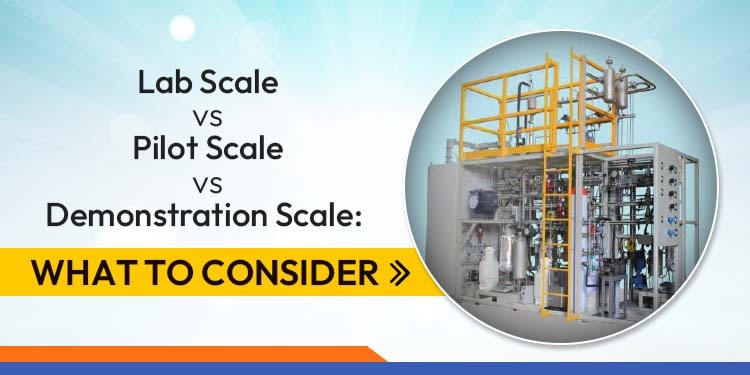Premier Pilot Plant People

Lab Scale vs Pilot Scale vs Demonstration Scale: What to Consider
In chemical and process industries, scaling a technology from concept to commercial production is not a simple linear journey. Every scale-up phase, from lab to pilot to demonstration, introduces new challenges that can define the success or failure of a process. At Xytel India, where pilot plants and modular process systems are at the heart of innovation, understanding the distinction between these scales is vital. Each stage serves a unique purpose in transforming laboratory research into a safe, efficient, and commercially viable process.1. Understanding the Three Scales
Lab Scale – The Foundation of Innovation
Lab-scale experimentation forms the backbone of process development. Typically involving volumes from milliliters to a few liters, this stage focuses on exploring chemical reactions, material behavior, and process feasibility.Key objectives:
- Establish reaction kinetics and mechanisms
- Test catalysts and reagents
- Evaluate yields, selectivity, and thermodynamic limits
- Identify potential safety and environmental concerns
Setup characteristics:
Lab systems are often glass-based or bench-top reactors with flexible manual controls. At this stage, the emphasis is on learning, not optimization. It’s where the science is proven before the engineering begins.Pilot Scale – Bridging Research and Reality
Once the fundamental chemistry is validated, the process must be tested under conditions that reflect industrial reality. This is where pilot plants come in, small-scale industrial systems, typically handling tens to hundreds of liters.Purpose:
- Validate laboratory data under continuous or semi-continuous conditions
- Observe scale-dependent effects like heat transfer, mass transfer, and mixing
- Optimize process control parameters and automation logic
- Evaluate material compatibility and corrosion behavior
- Collect reliable data for scale-up and economic feasibility
Demonstration Scale – The Final Validation Before Commercialization
The demonstration scale represents the final proof-of-concept before full-scale deployment. Typically operating at 10-20% of commercial capacity, these plants mirror the complete process flow, integrating every unit operation, utility, and control element.lab-vs-pilot-vs-demonstration-scale
- Validate process robustness and long-term operability
- Generate data for commercial plant design and economic projections
- Confirm product quality consistency and throughput
- Identify and address maintenance, fouling, or reliability issues
- Build confidence for investors, regulatory authorities, and stakeholders
2. Key Considerations Across the Scales
Scaling up is more than just increasing vessel size or flow rate. It involves understanding physical, chemical, and operational relationships that behave differently with volume and geometry. Below are crucial aspects to evaluate at each scale.Heat and Mass Transfer
- Lab Scale: Easy to maintain uniform temperature and mixing.
- Pilot Scale: Introduces thermal gradients, requiring improved heat exchangers and agitation design.
- Demonstration Scale: Must ensure efficient heat recovery and consistent transfer coefficients across the full process length.
Reaction Kinetics and Residence Time
At larger scales, residence time distributions can shift due to differences in flow behavior. Pilot and demonstration plants help refine these parameters for real-world throughput.Mixing and Flow Dynamics
Mixing efficiency drops with increased reactor size. Engineers must evaluate impeller geometry, fluid velocity, and turbulence to maintain uniform reaction conditions.Process Control and Automation
From manual controls in the lab to SCADA-based automation in pilot and demo units, instrumentation accuracy grows in importance. Integration of PID loops, interlocks, and safety shutdown systems ensures stable and safe operation.Material Selection and Corrosion Resistance
Material compatibility can change with temperature, pressure, or process impurities. Selecting appropriate metallurgy, seals, and gaskets at the pilot stage helps prevent costly redesigns later.Safety and Risk Management
Each scale introduces higher energy, pressure, and inventory levels. Conducting HAZOP studies, pressure-relief design, and emergency protocols becomes critical, particularly in demonstration plants.Utility and Energy Integration
Pilot and demo stages must consider steam, cooling water, compressed air, nitrogen, and power consumption. Early evaluation helps optimize utility networks and operating costs for commercial facilities.Economic Evaluation
Pilot-scale data provides the first realistic estimate of capital and operating costs. Demonstration-scale operations refine these projections to validate ROI and feasibility before full investment.3. Transitioning Between Scales – Challenges and Best Practices
From Lab to Pilot
- Verify reproducibility under continuous or semi-continuous flow.
- Identify scale-sensitive parameters (heat transfer coefficients, pressure drops).
- Design flexibility into the pilot setup to accommodate variable conditions.
From Pilot to Demonstration
- Shift focus from experimental optimization to operational stability.
- Incorporate industrial-grade control systems and continuous operation reliability.
- Address long-term issues such as fouling, catalyst deactivation, or corrosion through extended runs.
4. The Role of Modular Design in Scale-Up
A key enabler in modern process development is a modular, skid-mounted design. Xytel India specializes in custom-built pilot and demonstration plants that are modular, fully automated, and easy to scale or relocate.Advantages include:
- Reduced on-site construction time
- Easier integration with existing utilities
- Faster commissioning and start-up
- Simplified maintenance and expansion
5. Checklist Before Moving to the Next Scale
Before progressing to a larger system, ensure:- Complete mass and energy balance closure
- Validated reaction kinetics and thermodynamic data
- Defined process control strategy and safety interlocks
- Established material compatibility and corrosion testing
- Cost and utility analysis verified with pilot data
- Long-term operability demonstrated through sustained trials
Conclusion
Scaling a process is both a science and an art. From lab discoveries to pilot validation and finally demonstration of reliability, every stage is critical in turning an idea into a commercially successful technology. With over three decades of experience, Xytel India continues to bridge these gaps through turnkey pilot and demonstration plants designed for precision, safety, and scalability. Each step forward, when engineered with insight and expertise, ensures that innovation not only succeeds in the lab but thrives in the real world.Get in Touch
You will be amazed as how partnering with us becomes a game changer in your quest for R&D glory.

 Call Us
Call Us